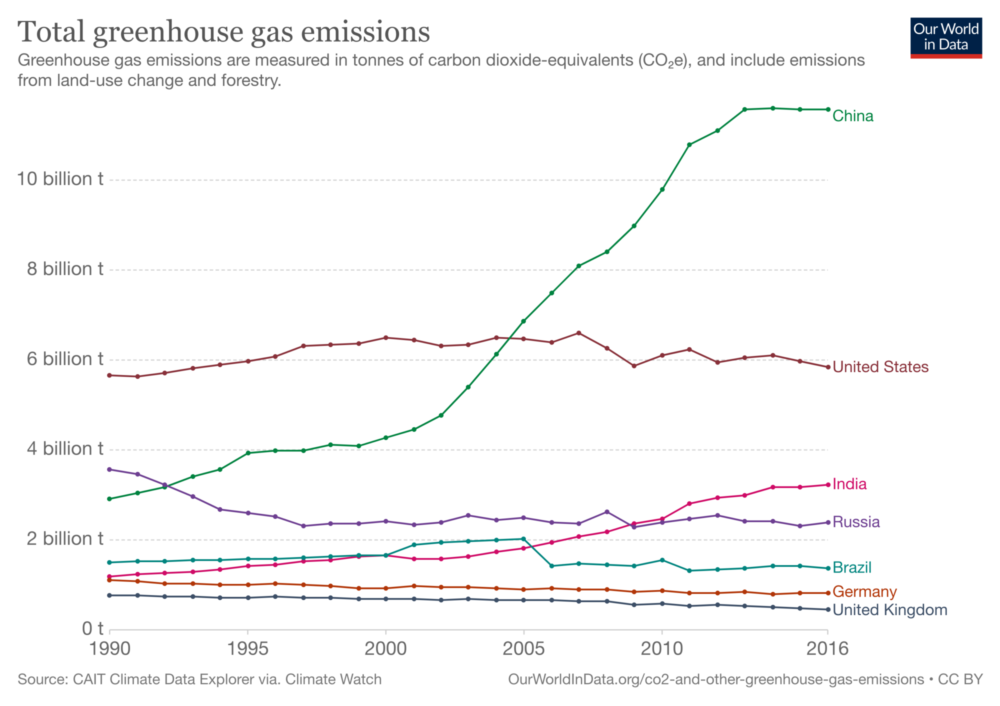Illustration by Frits Ahlefeldt
Global warming due to the greenhouse effect mostly stems from increased fossil-fuel consumption, and the resultant CO2 emissions. This is a matter of global concern, making it difficult for India to follow the fossil fuel-heavy development path adopted by the developed world. Historically, industrialization and development have been driven by the power sector. Adopting a new development model will be a challenge for India. The transition to fossil-free resources for power generation will have a significant impact on our emissions — especially with the rise in electricity demand due to economic progress and quality of life. More than 50 billion tons of CO2 equivalent was emitted in 2016 globally. China was responsible for around 24% of the total emissions, while the United States and India accounted for 12% and 6% respectively.

The power sector accounts for ~42% of CO2e emissions according to the biennial update report from the Ministry of Environment, Forest and Climate Change [i]. This is primarily due to the sector’s dependency on fossil fuels such as coal, oil, and natural gas. Over 77% of the electricity generated is from thermal power plants using coal and gas as the primary fuel [ii]. This share ought to shift in favor of renewable resources in order to reduce emissions from the power sector.
Paris Accord and India’s Contribution
Back in 2015, India pledged our climate targets to the United Nations Framework Convention on Climate Change (UNFCCC) vide Paris Accord and subsequently ratified the same in 2016. These targets, referred to as Nationally Determined Contributions (NDCs), include a 33%–35% reduction of the emissions intensity to GDP share by 2030 in comparison with the 2005 levels [iii]. Sustainable development is at the core of the NDC framework for achieving equitable and inclusive growth—thus, intersecting with more than 5 of the 17 Sustainable Development Goals (SDGs) stipulated to be achieved by 2030. To achieve these, the power sector will need to transition toward clean and green sources for generating electricity.
Decarbonization of the power sector would reduce our emissions drastically. This aligns well with the second key goal in the NDC, which aims at achieving 40% electricity generation (installed capacity) from fossil-free sources such as solar, wind, nuclear, and hydro. Concurrently, electricity from these resources will have a positive impact on the transport sector (electric vehicles), in addition to minimizing air pollution. The third goal aims at creating carbon sinks to negate the impact of emissions. This is outside the purview of our interest in this article. Hence it has not been covered.
Importance of Renewable Energy
Renewable energy accounts for over 24% of India’s power generation capacity equating to 88 Gigawatts(GW). This is expected to reach 175GW by 2022 and 450GW by 2030 according to the Ministry of New and Renewable Energy. Solar and wind energy will play a pivotal role in realising these goals. Every unit of renewable energy generated would decrease the overall grid emissions factor —represented as a unit of CO2 released for every unit of electricity generated across all power plants.
Key Metrics
The overall amount of CO2 emitted is a product of four key metrics — population, GDP/population, energy intensity to GDP, and carbon intensity of energy (denoted as CO2/energy).

- The carbon intensity of energy represents the ‘cleanliness’ of energy and is often determined by the electricity mix based on the source. This metric can be influenced by (a) switching to renewable energy-based electricity generation (solar and wind), (b) increasing the share of fossil-free resources (nuclear and hydro), and (c) substituting gas for coal-based thermal power plants.
- Energy intensity to GDP represents the role of energy efficiency, that is, the amount of energy required to generate a unit of GDP. This is particularly important as India embraces indigenous manufacturing through the Make in India program. In addition, energy efficiency can also be achieved through the adoption of efficient appliances in households. To achieve the NDC goal, according to our analysis [iv], India must reduce its energy intensity to GDP by 38%–45% over the 2005 levels.
- GDP per population is a result of income and technology. Income is derived from goods and services per person, often measured in rupees, whereas technology is a product of the carbon intensity of energy and energy intensity to GDP.
While emissions intensity to GDP is an important indicator for achieving the NDC goal, it is important to note that the energy for development is often measured by the energy per capita (per annum). The inequalities associated with per capita electricity consumption across other countries are shown in this figure. India’s per capita electricity consumption, in 2018, was around 1181 kWh—12 times lower than the United States and 4 times lower than China. Given the aspiration toward economic development and prosperity, this number is expected to increase three- to four-fold, at the very least, by 2030.
Conclusion
Power sector decarbonization and energy efficiency adoption are the two important levers that will govern India’s progress toward realizing NDC goals. As the income levels rise, the energy demand from households will increase too. Electricity for appliances, fuel for transport, and fuel for cooking are the different sources of energy in the residential sector. Although fuel switching and energy efficiency will yield desirable results in the short-run (2030), shifting this energy demand to 100% of electricity would be the most sustainable transition in the long run. Additionally, if this electricity comes from a renewable source, that would be ideal. This is, however, still a distant dream—given the myriad challenges associated with energy transitions and, most importantly, changing the mindsets and aspirations of the population.
[i] MoEFCC, Second Biennial Update Report to the UNFCC in 2014 (https://unfccc.int/sites/default/files/resource/INDIA%20SECOND%20BUR%20High%20Res.pdf)
[ii] CEA, Load Generation Balance Report 2020-21 (https://cea.nic.in/reports/annual/lgbr/lgbr-2020.pdf)
[iii]MoEFCC, India’s Intended Nationally Determined Contribution: Working Towards Climate Justice (https://www4.unfccc.int/sites/submissions/INDC/Published%20Documents/India/1/INDIA%20INDC%20TO%20UNFCCC.pdf)
[iv] CSTEP, Roadmap for achieving India’s NDC Pledge (https://cstep.in/drupal/sites/default/files/2020-04/CSTEP_Report_Roadmap_for_achieving_Indias_NDC_pledge.pdf)
